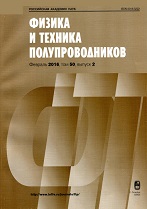|
Surface, interfaces, thin films
Cobalt-doped chemically precipitated lead sulfide films
L. N. Maskaevaab, E. V. Mostovschikovac, V. F. Markovab, V. I. Voroninc, A. V. Pozdina, I. O. Selyanind, A. I. Mikhailovaa
a Ural Federal University named after the First President of Russia B. N. Yeltsin, Ekaterinburg
b Ural Institute of the State Fire Service
c Institute of Metal Physics, Ural Division of the Russian Academy of Sciences, Ekaterinburg
d Institute of Solid State Chemistry, Urals Branch of the Russian Academy of Sciences, Ekaterinburg
Abstract:
This work is a continuation of studies on the doping of chemically deposited PbS(I) layers and discusses the effect of cobalt ions on films' morphological, structural, optical, and photoelectric properties. Elemental energy–dispersive analysis showed that cobalt was detected in films at the $\ge$ 0.04 mol/l CoCl$_2$ concentration in the reaction mixture. The produced PbS(I, Co) films retain the $B$1 cubic structure (space group). An established trend of the PbS(I, Co) films band gap increase from 0.57 to 0.75 eV is connected with an increase in the content of nanoparticles in them from 1 to $\sim$8% for deposition during 1.5 h. For a 3-hour process, we also observed a bandgap increase from 0.57 to 0.68 eV corresponding to the fraction rise of nanoparticles – from 13 to $\sim$28%. The concentration dependence of the PbS(I, Co) films volt sensitivity deposited for 1.5 h exhibits two maxima corresponding to 1 and 4% nanoparticle contents. During a three-hour synthesis process, a sharp photoresponse decrease was noted with an increase in the content of nanoscale particles to $\sim$13–28% in the PbS(I, Co) layers. We showed that the photocurrent density decreases with an increase in the content of nanoparticles in the films in the series PbS(Co)$\to$PbS$\to$PbS(I, Co)$\to$PbS
Keywords:
lead sulfide, chemical deposition, cobalt doping, film morphology, structural properties, band gap, voltage and current photosensitivity.
Received: 02.07.2021
Revised: 16.07.2021
Accepted: 16.07.2021
Citation:
L. N. Maskaeva, E. V. Mostovschikova, V. F. Markov, V. I. Voronin, A. V. Pozdin, I. O. Selyanin, A. I. Mikhailova, “Cobalt-doped chemically precipitated lead sulfide films”, Fizika i Tekhnika Poluprovodnikov, 55:11 (2021), 1049–1058
Linking options:
https://www.mathnet.ru/eng/phts4941 https://www.mathnet.ru/eng/phts/v55/i11/p1049
|


| Statistics & downloads: |
| Abstract page: | 71 | | Full-text PDF : | 34 |
|





 Contact us:
Contact us: Terms of Use
Terms of Use
 Registration to the website
Registration to the website Logotypes
Logotypes








 Citation in format
Citation in format 